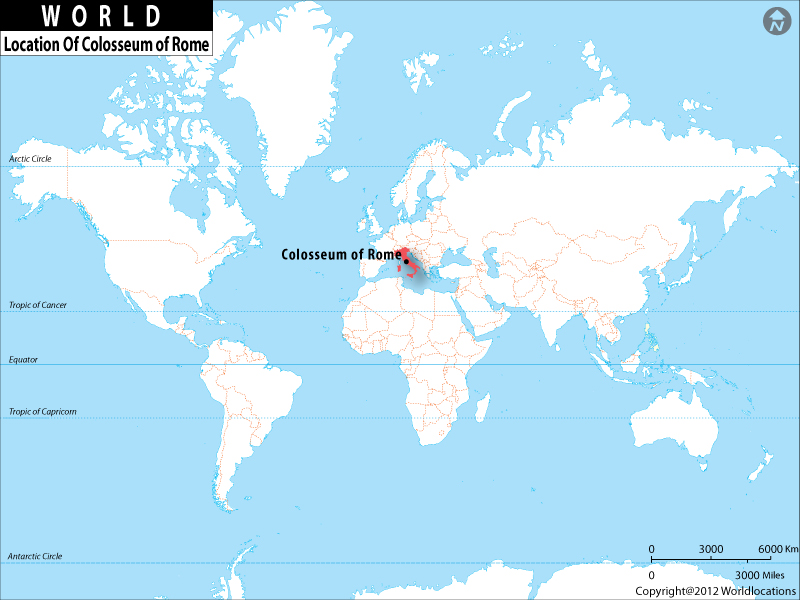The Colosseum, also known as the Flavian Amphitheatre, is located in Rome, Italy. It is situated in the heart of the city, just east of the Roman Forum and southwest of the Palatine Hill. The Colosseum is an ancient Roman amphitheater and stands as one of the most iconic landmarks in Rome.
Location Map of Colosseum of Rome
 About Map: Map showing Where is Colosseum of Rome, located in the Map.
About Map: Map showing Where is Colosseum of Rome, located in the Map.
About Colosseum of Rome
The Colosseum, also known as the Flavian Amphitheatre, is an ancient Roman amphitheater located in the city of Rome, Italy. Here are some key details about the Colosseum.Construction and Purpose: The Colosseum was built between 70-80 AD during the Flavian dynasty. It was commissioned by Emperor Vespasian and completed under his successor, Titus. The purpose of the Colosseum was to host various forms of public spectacles, including gladiatorial contests, animal hunts, mock naval battles, and theatrical performances.
Architecture and Design: The Colosseum is an impressive architectural marvel, characterized by its elliptical shape and grand scale. It measures approximately 189 meters (620 feet) in length, 156 meters (510 feet) in width, and stands about 48 meters (157 feet) tall. It was primarily constructed using travertine stone and concrete. The amphitheater consists of multiple levels of seating, divided into different sections for various social classes.
Capacity and Spectators: The Colosseum was capable of accommodating a large number of spectators, with estimates ranging from 50,000 to 80,000 people. The seating arrangement was designed to provide the best views of the events taking place in the arena. The structure had different entrances and exits to facilitate the flow of the audience.
Significance and Historical Importance: The Colosseum holds immense historical and cultural significance as one of the greatest symbols of ancient Rome. It reflects the engineering and architectural prowess of the Roman civilization. The amphitheater was not only a venue for entertainment but also served as a powerful tool for political and social control.
Preservation and Tourism: Despite centuries of damage and pillaging, the Colosseum has survived and remains an iconic landmark of Rome. It has undergone several restoration projects to preserve its structure and showcase its historical value. Today, the Colosseum is one of Rome's most popular tourist attractions, drawing millions of visitors who come to explore its ruins, learn about its history, and witness its grandeur.
The Colosseum stands as a testament to the grandeur of ancient Rome, attracting visitors from around the world who are captivated by its historical significance, architectural beauty, and the stories of the spectacles that once took place within its walls.
World Travel Destinations
- 100 Wonders Of The World
- 7 Wonders Of World
- Where is Acropolis
- Where is Alhambra
- Where is Amalfi Coast
- Where is Amazon Rainforest
- Where is Angel Falls
- Where is Angkor Wat
- Where is Bali
- Where is Banaue Terraces
- Where is Bora Bora
- Where is Borobudur
- Where is Burj Khalifa
- Where is Cappadocia
- Where is Carlsbad Caverns
- Where is Chichen Itza
- Where is Colosseum Of Rome
- Where is Dubrovnik
- Where is Easter Island
- Where is Eiffel Tower
- Where is Fjords Of Norway
- Where is Galapagos Islands
- Where is Grand Canyon
- Where is Great Barrier Reef
- Where is Great Pyramid Of Giza
- Where is Great Wall Of China
- Where is Iguazu Falls
- Where is Konark Temple
- Where is Leaning Tower Pisa
- Where is Louvre Museum
- Where is Machu Picchu
- Where is Marrakesh
- Where is Matterhorn
- Where is Mecca
- Where is Mount Everest
- Where is Pagan Temples
- Where is Petra
- Where is Pompeii
- Where is Portofino
- Where is Potala Palace
- Where is Sahara Desert
- Where is Santorini
- Where is Sistine Chapel
- Where is Stonehenge
- Where is Suez Canel
- Where is Taj Mahal
- Where is Teotihuacan
- Where is Terracotta Warriors
- Where is Valley Of The Kings
- Where is Versailles
- Where is Victoria Falls
- Where is Mount Rushmore
- Where is Prague
- Where is Tunis
- Where is Curacao
- Where is Babylon
- Where is Death Valley
- Where is Tahiti
- Where is Oak Island
- Where is Mount Fuji
- Where is Timbuktu
- Where is Canary Islands
- Where is Monte Carlo
- Where is Atlantis
- Where is Dead Sea
- Where is Amalfi Coast
- Where is Kosovo
- Where is Great Barrier Reef
- Where is Panama Canal
- Where is The Red Sea
- Where is Aconcagua Mountain
- Where is Azores
- Where is Devil'S Tower
- Where is Antwerp
- Where is The Faroe Islands
- Where is Santorini
- Where is Kilimanjaro
- Where is Banff National Park
- Where is Mount Olympus
- Where is Ninevah
- Where is Mount Etna
- Where is Deadwood
- Where is Lake Titicaca
- Where is Yucatan Peninsula
- Where is Mount Mckinley
- Where is Angel Falls
- Where is The Blue Lagoon
- Where is Petrified Forest
- Where is Rock Of Gibraltar
- Where is Glass Beach
- Where is Atacama Desert
- Where is Mount Ararat
- Where is Falkland Islands
- Where is Channel Islands
- Where is Badlands National Park
- Where is Tree Of Life
- Where is Dubrovnik
- Where is Loch Ness
